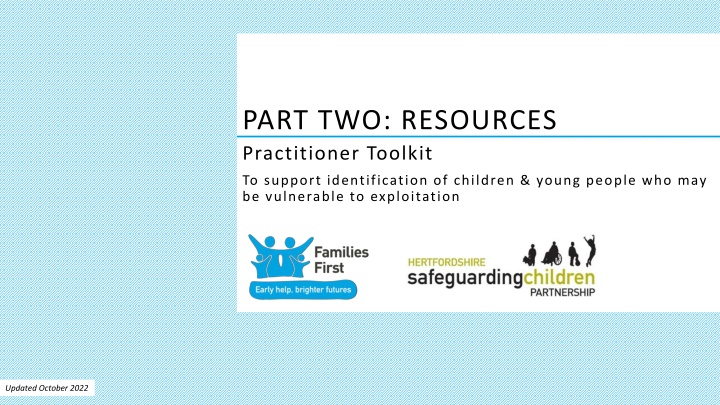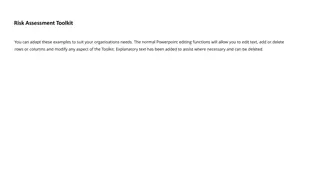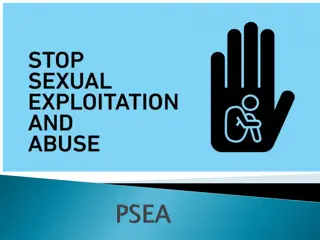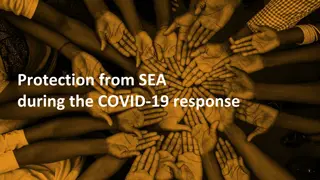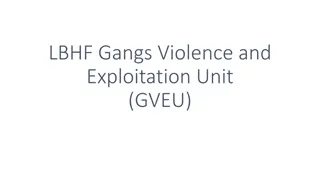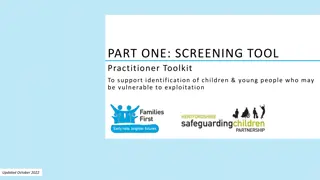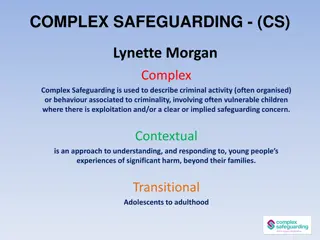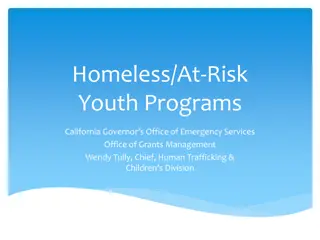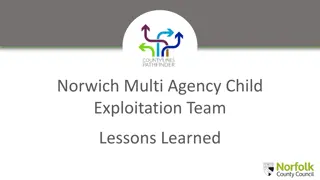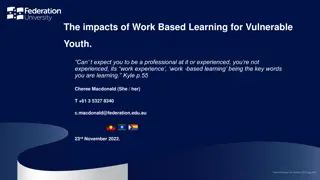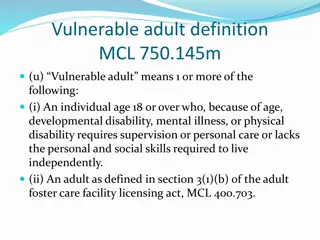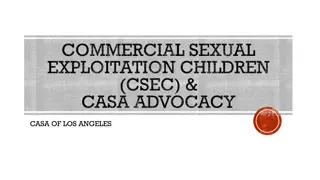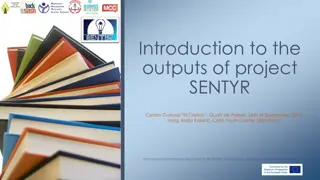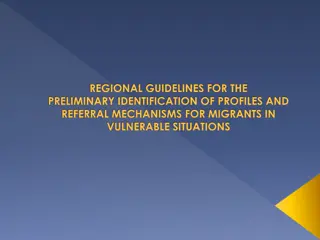Toolkit for Identifying Vulnerable Children and Youth at Risk of Exploitation
This toolkit provides resources to support practitioners in identifying children and young people who may be vulnerable to exploitation. It includes a glossary of terms related to exploitation, information on Prevent concerns, safety and support plans, and ways to deliver anti-abuse curriculum. The content covers various forms of exploitation like child criminal exploitation, child sexual exploitation, and trafficking, offering insights into the complexities and signs of these abuses.
Download Presentation

Please find below an Image/Link to download the presentation.
The content on the website is provided AS IS for your information and personal use only. It may not be sold, licensed, or shared on other websites without obtaining consent from the author.If you encounter any issues during the download, it is possible that the publisher has removed the file from their server.
You are allowed to download the files provided on this website for personal or commercial use, subject to the condition that they are used lawfully. All files are the property of their respective owners.
The content on the website is provided AS IS for your information and personal use only. It may not be sold, licensed, or shared on other websites without obtaining consent from the author.
E N D
Presentation Transcript
PART TWO: RESOURCES Practitioner Toolkit To support identification of children & young people who may be vulnerable to exploitation Updated October 2022
Glossary of Terms Prevent What is Prevent? What do I do if I have a Prevent concern? Safety and Support Plan What is a Safety & Support Plan? Process Organisational / Whole School Approach Delivering an Anti-Abuse Curriculum Safeguarding Through the Curriculum: Child Sexual Exploitation Safeguarding Through the Curriculum: Child Criminal Exploitation CONTENTS 2
GLOSSARY OF TERMS This section seeks to provide a glossary of terms commonly associated with exploitation. This is not an exhaustive list. Exploitation, is a form of abuse where an individual or group takes advantage of an imbalance of power to coerce, manipulate or deceive a child or young person into sexual or criminal activity in exchange for something the victim needs or wants, and/or for the financial advantage or increased status of the perpetrator or facilitator. Child exploitation typically involves physical violence, threats of violence and intimidation. Involvement is usually characterised by the child or young person s limited availability of choice as result of their social, economic or emotional vulnerability. The victim may have been exploited even if the activity appears consensual. Exploitation does not always involve physical contact, it can also occur through the use of technology. It is a multi-faceted and complex type of abuse which comes in many forms which often are layered and interconnected. Child Criminal Exploitation - Occurs where an individual or group takes advantage of an imbalance of power to coerce, control, manipulate or deceive a child or young person under the age of 18 into criminal activity. Child Sexual Exploitation - A form of child sexual abuse. It occurs where an individual or group takes advantage of an imbalance of power to coerce, manipulate or deceive a child or young person under the age of 18 into sexual activity (a) in exchange for something the victim needs or wants, and/or (b) for the financial advantage or increased status of the perpetrator or facilitator. Trafficking - Recruitment, movement or transportation (across houses or hotels; towns or cities; within communities and sometimes internationally) of children who are then exploited, forced to work or sold between groups of perpetrators. Includes child sexual exploitation (organised /networked sexual exploitation); benefit fraud; domestic servitude; criminal activity such as pickpocketing, begging, transporting drugs, working on cannabis farms, selling pirated DVDs and bag theft. 3
CONT. 1 Gangs - A relatively durable, predominantly street-based group of young people who: see themselves (and are seen by others) as a discernible group; engage in criminal activity and violence; and may also lay claim over territory (not necessarily geographical, but can include an illegal economy territory); have some form of identifying structural feature; and/or be in conflict with other, similar, gangs. There are many different and complex reasons as to why people join gangs: for status to feel a sense of belonging to make money to earn respect for protection from other gangs Many street gangs are involved with the supply and dealing of drugs. Children and young people involved with, or on the edges of, gangs might be victims of violence, be pressured into doing things like stealing or carrying drugs or weapons. They may have been abused, exploited or put into dangerous situations. CSE can also happen to young people in gangs and can involve: using sex as a means of initiating young people into the gang a young person performing sexual acts in return for protection or status inflicting sexual assault as a weapon in conflict entrapping a rival gang member by feigning sexual interest or establishing a relationship with them 4
CONT. 2 Organised Exploitation - The young person is being coerced, groomed or sexually exploited by a network of perpetrators. Peer Exploitation - The child/young person is in a relationship with another young person who is coercing them into sexual activity with their friends. This is the model that gang related exploitation typically follows. County Lines - County lines is a term used to describe gangs and organised criminal networks involved in exporting illegal drugs into one or more importing areas within the UK, using dedicated mobile phone lines or other form of deal line . They are likely to exploit children and vulnerable adults to move and store the drugs and money and they will often use coercion, intimidation, violence (including sexual violence) and weapons. Cuckooing - Where people take over a person s home and use the property to facilitate exploitation. The most common form is where drug dealers take over a person s home and use it as a base to store and distribute drugs Money and weapons may also be stored at the property. Radicalisation - Radicalisation is defined as the process by which people come to support terrorism and extremism and, in some cases, to then participate in terrorist groups. Missing - Anyone whose whereabouts cannot be established and where the circumstances are out of character or the context suggests the person may be subject of crime or at risk of harm to themselves or another. Sexting - Sexting is when someone shares sexual, naked or semi-naked images or videos of themselves or others, or sends sexually explicit messages. They can be sent using mobiles, tablets, smartphones, laptops - any device that allows you to digitally share media and messages. Sexual Harassment - Unwanted conduct of a sexual nature that can occur online and offline. Sexual harassment is likely to violate a child s dignity, and/or make them feel intimidated, degraded or humiliated and/or create a hostile, offensive or sexualised environment. Sexual Offences - Sexual offences under the Sexual Offences Act 2003 as described below: Rape: Person (A) commits an offence of rape if: he intentionally penetrates the vagina, anus or mouth of person (B) with his penis, without the consent or reasonable belief that consent was gained from person (B). Assault by Penetration: Person (A) commits an offence of assault by penetration if: s/he intentionally penetrates the vagina or anus of person (B) with a part of her/his body or anything else in a sexual manner, without the consent or reasonable belief that consent was gained from person (B). Sexual Assault: Person (A) commits an offence of sexual assault if: s/he intentionally touches person (B) in a sexual manner without the consent or reasonable belief that consent was gained from person 5
What is Prevent? The Government s Prevent Strategy is part of the overall Counter-Terrorism Strategy, CONTEST. Prevent aims to reduce the threat to the UK from terrorism by stopping people becoming terrorists or supporting terrorism through three strategic objectives: PREVENT - Tackle the causes of radicalisation and respond to the ideological challenges of terrorism Safeguard and support those most at risk of radicalisation through early intervention, identifying them and offering support Enable those who have already been engaged in terrorism to disengage and rehabilitate - - What to do if you have a Prevent concern? NOTICE Are you worried that a child is at risk of extremist behaviour or radicalisation? CHECK Speak with the child-/young person to get a better understanding of what they are saying. SHARE If you still have concerns, make a referral. Complete National Referral form Send to Hertfordshire Prevent at prevent@herts.pnn.police.uk 6
What is a Safety & Support Plan? The safety and support plan is not a legal document and the process is not adversarial, it is a voluntary and consensual tool that schools can use to engage a child/young person and their parents/carers to identify any risk, concerns or aspects of vulnerability, It is a way of agreeing and implementing support strategies reduce and minimise any potential risk to the child /young person or others. SAFETY & SUPPORT PLANNING It is not a specialist assessment tool and is designed to complement any universal, targeted or specialist support already being offered, where applicable. The development, implementation and review of this document are the responsibility of the school. Support and guidance during the process is available from the Child Protection Schools Liaison Team, if required. This plan will often require the support and cooperation of parents/carers. The plan can be considered for children / young people who are at risk of Criminal and Sexual Exploitation (CSE) and/or associated with gangs, youth violence, this has been adapted from the universal version that is available on the Hertfordshire Grid for Learning. What is the aim of a Safety & Support Plan? The aim is to ensure that a child/young person have the opportunity to express their wishes and feelings and be enabled to say how they may be assisted to feel supported and safe in their education setting. If you are unsure about the level of risk or harm, call the Consultation Hub for Schools on 01438 737511 (this number is for professional use only). 7
Should the need for a safety and support plan be identified, the process should run as follows: PROCESS As part of this discussion consideration given to any other key professionals that need to be involved and any resources needed to support the plan. School/education setting to prepare a draft plan based on the discussion with parents/carer, CYP and other agencies / resources if relevant. Designated safeguarding practitioner/lead to discuss/meet with CYP & parents/carer to establish if a plan is required. Safety and support plan to be shared and finalised with CYP and parents/carer, this should include all parties signing the document as part of the agreement to comply with the support strategies that will be implemented. Form included in this document All participants to receive a signed copy. School/education setting to use chronology to monitor and record for ongoing review of the CYP s circumstances and safety. Agree dates to review the plan as necessary. 8
SAFETY & SUPPORT PLAN Risk is defined as uncertain prediction about future behaviour with a chance that the future outcome of the behaviour will be harmful or negative (Kemshall, 1996) Context of concerns/behaviour what has happened and why is plan needed? Use the Indicator of Checklists on pages 10-20 and Analysis of Checklist on page 21 of Part One: Screening Tool to assist you. CYP Name DOB Ethnicity (optional) Educational Setting Form Date Please also use the Assessment Of The School Environment Tool to support completion of this Safety & Support Plan, particularly when considering support strategies/measures to implement regarding the school environment. 9
IDENTIFICATION OF CONCERNS & ANY RISKS What are the concerns and risks? Please list or bullet point In what situation could this occur? E.g. physical environment of your setting; unstructured times; transition points; travel etc What factors heighten the concerns and risks? Think about worst case scenario What factors lower the concerns and risks? Think about protective factors that could help reduce risk 10
VIEWS OF THE CYP & PARENT/CARER CYP s response/view of the concerns raised. Do they support and agree that this plan will assist them? Parent/Carer View? Do they support and agree to this plan? 11
VIEWS OF OTHER PROFESSIONALS Please use this space to record the views of other agencies regarding CYP s needs. This should include services and resources offered in the past and currently. Any other recommendations for support and safety of child or others? Examples of other agencies include Health, Police, Early Help services e.g. SfYP, SASH, Family Centres, LSPs, Children s Services Safeguarding or Specialist 12
SUPPORT STRATEGIES/MEASURES TO IMPLEMENT Liaise with parents/carers. Who and how frequently? What are the arrangements for reporting, recording and monitoring child s behaviour? Liaise with CYP. Who is their key person should they need to sound off / express their wishes? Who would be available if that person is not in school? Duty of care/keeping all pupils safe. How will this be done? Who will coordinate? What messages have been given to children about keeping safe and how? 13
CONTINUED 1 The right to be safe. What messages have been given about the right to be safe? How can this be reinforced? How safe does the CYP feel? Behaviour management strategies. Are there clear boundaries and expectations of acceptable behaviours? Off-site activities e.g. school trips, work experience. How will risk be managed in these situations? Transport arrangements. What are the arrangements for the CYP to get safely to and from school/college? 14
CONTINUED 2 School environment. Is it likely that the cause of concerns means that the CYP will be in the same area of the school/setting? Is there a joint friendship group? How will the need for no contact be managed if necessary? Individual support. What access to support has the CYP been offered? Is there an identified programme of work? If so, what is it and who is delivering? Family support. Are the family being offered any support? Do they need it? Are there are services that the school/setting can signpost to? Information sharing. If time out of lessons is needed how will the school/setting support the child with a cover story to explain to friendship groups? Are there any key members of staff that need to know about this plan/parts of it to keep the CYP safe? Who are they? What will be shared and why? 15
CONTINUED 3 Chronology of incidents. Who will be responsible for monitoring and updating this? Inclusion and diversity. Are there any additional factors to consider in relation to the CYP s age, sex, race, religion, disability, mental/physical health or other? Exclusion temporary or permanent. Are there significant grounds for considering this? Has there been an assessment of the situation? If so, what is the evidence for this decision? Date and venue for Safety & Support Plan Review: 16
IMMEDIATE RESPONSE TO INCIDENT OR CONCERNS Actions to be taken immediately if an incident takes place, new concerns arise or current concerns continue with no change School: 1. 2. 3. 4. Inform parents / carer. Consider safety of child (arrange for child to be picked up from school if necessary). Consider safety of other children within the school community. If a child has suffered significant harm/is at immediate or imminent risk, school to make a child protection referral on 03001 234 043 and Police where relevant. If child not at immediate/imminent risk, call the Consultation Hub on 01438 737511. Review plan and re-evaluate any risk factors, if relevant . Discuss the expectations with young person & Family and record their responsibilities. 5. 6. 7. CYP: Parents/Carer: 17
CONSENT & AGREEMENT TO PLAN Name Role Signature Headteacher / Principal Designated Safeguarding Person (DSP) Form Tutor / Class Teacher Other relevant school staff Child/Young Person Children s Services Police (if involved) Other Universal or Targeted Services Parents/Carer (must have parent/carer consent, without it plan cannot go ahead) 18
REVIEW OF SAFETY & SUPPORT PLAN Using the Safety and Support Plan and the chronology re any incidences, evaluate whether any changes need to be made to the Safety and Support Plan? A review will consider any new information, change in circumstances any work carried out with the child and family by school or other agencies/universal resources e.g. GP. Include any positive outcomes. Actions/amendments By who and by when? 19
Please be aware that this document is not regularly updated, nor are the services advocated by the CPSLO. It is the responsibility of the setting to check content and use due diligence in deciding which services to use, all links were accurate at the time of writing and some resources may have cost implications. ORGANISATIONAL / WHOLE SCHOOL APPROACH Over the following pages you will find suggestions and resources to support a organisational / whole school approach split into the below categories: - - - - - - - - - Policy & Procedures Staff Training & Awareness Training Resources Key Document & Links Parent / Carer Resources Multi-Agency Working Safeguarding Through The Curriculum Pastoral Support Delivering an Anti-Abuse Curriculum 20
Make reference to exploitation, in all its various forms, and peer on peer abuse in the Child Protection Policy POLICY & PROCEDURES Consider having an Exploitation Champion , perhaps one of the DSP/L (Designated Safeguarding Practitioners/Leads) Implement a robust attendance policy & supporting procedures Provide a safe learning environment and procedures for non-learners on site Establish robust behaviour and anti-bullying policies which cover outside of school as well as in contextual safeguarding approach Consider weapons policy, if deemed necessary Ensure that your Safeguarding Governor provides governance and scrutiny of how the school deals with CSE/Gangs and children at risk of exploitation, including staff knowledge Ensure e-safety procedures are robust and pupils are being taught about online risks, how to recognise unsafe contact and how they can report any concerns to peers and staff 21
STAFF TRAINING & AWARENESS Safeguarding mapping within the curriculum Regular meetings between DSP/L, SLT, class teachers and pastoral leads to allow opportunity for collective concern sharing Ensure children, parents and staff to know the names of the DSP/L and deputy to whom they can communicate their concerns Have staff members at the school entrance at the beginning and end of school this will enable schools to identify any unusual behaviour e.g. pupils receiving lifts from unrelated / unknown adults or other people of concern. They may also assist police with collecting evidence should they need to prosecute Ensure children/young people are consulted about their learning Risk Assessment Management Plan Familiarity with Risk Assessment Management Plan and associated guidance in relation to children or young people displaying problematic or harmful sexualised behaviour Training for gangs/youth violence should include an understanding of the local community and it s issues, knife awareness, safe searching, incident handling, conflict resolution, anger and behaviour management, relevant legal issues and some knowledge of street slang Work in partnership with HSCP and other local authorities for children who live outside the county Early Intervention Foundation Early Intervention Foundation provides early intervention strategies to prevent gang involvement and youth violence meeting the needs of young people with learning disabilities who experience or are at risk of sexual exploitation Practice Guidance on meeting the needs of young people with learning disabilities who experience or are at risk of sexual exploitation 22
TRAINING RESOURCES Staff should have a good level of understanding about exploitation, in all its forms, and associated risks. They should be able to spot the signs of children at risk of exploitation, know how to report this both internally and to outside agencies and be aware of the relevance within your community. BBC Radio 4 podcast- Crossing the Line - Britain's Teenage Drug Mules NSPCC online course Safeguarding and child protection training in schools | NSPCC Learning Contextual Safeguarding Network -Resources Protecting children from trafficking and modern slavery | NSPCC Learning offer training to professionals Hertfordshire s Safeguarding Children Partnership - Child Sexual Exploitation in Hertfordshire CPD: Brook Sexual Behaviours Traffic Light Tool (RSE) Course this tool helps professionals to identify, understand and respond appropriately to sexual behaviours in young people. HSAB and HSCP training and resources | Hertfordshire County Council professionals can access training courses delivered by Hertfordshire s Safeguarding Children Partnership. Zero Suicide Alliance offer FREE suicide prevention training course on how to recognise the warning signs and safeguard someone that could be contemplating suicide. Healthy Young Minds in Herts has a section for school staff working with children and young people who live in Hertfordshire who want to know more about local emotional wellbeing services KIP education provides training for professionals to take on sessions and interventions that they may have previously found uncomfortable Fearless Professionals Training FREE awareness sessions for professionals What Is County Lines? | The Children's Society (childrenssociety.org.uk) The Children s Society s Slang Dictionary seeks to support professionals in better understand the language young people may be using. Criminal exploitation and gangs | NSPCC Sexual abuse toolkit - Hertfordshire Grid for Learning (thegrid.org.uk) 23
Sex and relationships - Hertfordshire Grid for Learning (thegrid.org.uk) Child sexual and criminal exploitation - Hertfordshire Grid for Learning (thegrid.org.uk) Criminal exploitation of children and vulnerable adults: county lines, Home Office September 2018 Children Missing Education , DfE 2016 Preventing youth violence and gang involvement: Practical advice for schools and colleges (PDF) Home Office 2013 Searching, screening and confiscation at school, DfE 2018 Drug Advice for Schools, DfE & ACPO 2012 Sexual Violence and Sexual Harassment between children in schools and colleges (DfE, 2017) Children Missing Education , DfE 2016 Child sexual exploitation: definition and a guide or practitioners, local leaders and decision makers working to protect children from child sexual exploitation , DfE 2017 Sexting in schools: advice and support around self generated images provides practical advice about how schools should respond to a sexting incident, including how to support a child whose image has been shared. KEY DOCUMENTS & LINKS 24
PARENT / CARER RESOURCES A guide for parents of Primary School aged children on keeping safe away from home Hertfordshire Safeguarding Children Partnership Sexual Exploitation website Spot the warning signs CSE for parents Know about CSE resources for schools to give parents Child sexual exploitation (CSE) | Barnardo's (barnardos.org.uk) It's Not Okay - Parents (itsnotokay.co.uk) Parents Against Sexual Exploitation (PACE) have produced a free online interactive package for parents on the signs of child sexual exploitation NSPCC Child Trafficking Advice Centre to discuss any concerns you may have for a child NSPCC PANTS campaign for parents of primary school aged children CSE parent support pack Advice to parents and carers on gangs leaflet from the Home Office provides advice to help parents/carers stop their children from being involved in gangs KIP education offers information sessions/parents evenings on substance misuse, sexual health and many more topics Mind Ed for Families is a free learning resource about the mental health of children, young people and older adults Healthy Young Minds in Herts is designed to give parents and carers information on the help available for children and young people who may be experiencing emotional or mental health difficulties Victim Support for parents Fearless a website where young people can access non-judgemental information and advice about crime and criminality, as well as anonymously report crime NSPCC gang helpline a 24-hour helpline (0800 800 500) to help parents, carers or any other adult worried about a child or young person at risk from gang-related activity. This includes children and young people who are not themselves in a gang, but may be at risk of being targeted by gang members 25
ADDITIONS Multi-Agency Working Establish links with your local Neighbourhood Police team they are able to provide visits to school, liaise on localised issues and provide educational resources e.g. personal safety, substance abuse Establish links with local Community Safety Partnership (District/Borough Council) Establish links with local community and voluntary agencies Safeguarding Through The Curriculum SRE education & Anti-bullying curriculum Drug and alcohol education Other opportunities for safeguarding through curriculum (see pages 28-32) Participate and promote awareness raising/campaign weeks Employment and career promotional activities keynote speakers, positive role models, links with Services for Young People, colleges, The Prince s Trust PSHE and personal development programmes HFL Education Anti-Abuse Curriculum (see page 27) Pastoral Support Resilience training, Protective Behaviours, mentoring, enrichment activities Access or signposting to counselling/therapy/mental health services as necessary Restorative approaches - justice, conflict resolution programmes & targeted social skills training 26
DELIVERING AN ANTI-ABUSE CURRICULUM As a school owned and led social enterprise, we aim to work with every school, setting and trust in Hertfordshire, providing a full range of high- quality products, services, and training to support them to deliver a great education Read the full Delivering an Anti-abuse Curriculum The development of this document was supported by Herts for Learning s Wellbeing Advisor, Karin Hutchinson Created August 2018; Updated June 2021 Herts for Learning 01438 544464 info@hfleducation.org 27
SAFEGUARDING THROUGH THE CURRICULUM: CSE Primary and Secondary School Resources Child Sexual Exploitation (P) Indicates that resource is only for primary school children, (S) only Secondary school children & (L) specifically for children with SEN (P) Jigsaw for 8 10 year olds YouTube: Helps young people understand what is personal information and why putting it online can make you vulnerable. (P) Lee and Kim's adventure - An 8-minute animation aimed at 5-7 year olds. This cartoon is produced by the Child Exploitation Online Protection Centre (CEOP) as part of their ThinkUKnow Programme. It introduces Lee & Kim, a brother and sister navigating the online world with the help of their trusted superhero friend SID (S) Consequences - Assembly that informs 11 16-year-olds how easy it is to gain their information, through social media, and how this is used to exploit young people. (S) Chelsea s Story raising awareness around Child Sexual Exploitation (S) Your Voice Your Choice workshop - Herts Young Homeless provides vital information to help keep young people informed and safe in their intimate relationships. (S) KIP education offers lessons/workshops for children in KS3 and KS4 covering a wide range of PSHE topics, including sex and relationships, substance misuse, CSE and many more. Disrespect Nobody- The Home Office PSHE education teaching materials are designed to support the Government s campaign to help prevent abusive behaviours within young people s relationships. These teaching materials are designed to help pupils understand and maintain healthy relationships while learning about consent and challenging controlling behaviour, violence and abuse. The resource also focuses on developing key skills and attributes intrinsic to healthy relationships - such as empathy, respect, communication and negotiation. Lesson plans for KS2-5 It s Not Okay - resource website created through Project Phoenix in the aftermath of the CSE enquiry in Greater Manchester. There is a resource pack for primary schools to support children to become responsible digital users and to raise their awareness of the risks of some behaviour online irrespective of the technology they are using (S) Real Love Rocks - resource pack developed by Barnardo s for and by young people. The content is based on 4 areas; healthy relationships, CSE, keeping safe and the impact of porn and sexting 28
(S) Healthy and Safe Relationships a unit of learning from Solihull for secondary aged young people around healthy relationships. The learning opportunities covered by this unit are wide-ranging, including: promoting positive sexual health; understanding the features of equal, respectful and consensual relationships; tackling abusive relationships; managing risk and keeping safe; and safeguarding against grooming and child sexual exploitation. A PDF version is also available to support one-to-one or group work with those who have been identified as being at risk from CSE (P) Happy and Safe Relationships - This resource is aimed at pupils in lower key stage 2 and will support teachers delivering PSHE in addressing the often sensitive areas of relationships and personal safety both on and off-line (S) Bwise2 Sexual Exploitation - pack equipping teachers to educate young people about sexual exploitation with honesty and realism (S) Friend or Foe who can you trust? - sexual exploitation and relationships education programme developed in Sheffield (S) Mentor - Adepis have developed a series of lesson plans which aim to provide a specific but flexible pathway to enable children to consider ways to develop resilience, reducing risk-taking and considering safer options. There are lessons for key stage 2. Videos (L) Know your friends with Josh and Sue is an animation video looking at how to protect yourself online. This is aimed at children and young people with mild moderate special educational needs. A supporting activities and lesson plan is available from the CEOP site. Sam s real friends - Signing and subtitles a video dramatization looking at how to protect yourself online. The actors in this film use British Sign Language and subtitles are also included. A supporting activities and lesson plan is available from the CEOP site. (P) Alright Charlie is a resource designed for use with children aged 9-11 in primary schools and aims to highlight the warning signs of grooming in an age appropriate way. It has been developed by the BLAST Project. This is available with signing and subtitles (S) Me, Jenny and Kate tells the story of three girls retelling what has happened to them (P) Consent - YouTube clip could be used to explain consent to primary aged pupils. (P) Play Like Share resource for eight to-ten year olds. This three-episode animated series and accompanying resource pack aims to help children to learn how to stay safe from sexual abuse, exploitation and other risks they might encounter online such as sharing content. (P) Talk PANTS with Pantosaurus and his PANTS song helps parents of 4-11 year olds keep their children safe from abuse. Free teacher s pack available. #consentiseverything video (S) Breck's Last Game highlights the risks of grooming by asking the question: Do you know who your online friends really are? (S) Caught in Traffick - aims to highlight the issue of internal human trafficking and child sexual exploitation. 29
Other Resources British Institute of Learning Disabilities (BILD) - resources and reports about CSE and SEND Know about CSE resources for teaching for ages 8 12 'Wud U? Barnardo s free app for young people - an educational tool for teachers and care professionals who interact with young people that might be at risk of sexual exploitation Barnardo s E Learning Course - designed for young people to use in school and a Teacher s Resource Pack, with reflective sessions to use in the classroom Relationships and sex education (including PSHE) - Hertfordshire Grid for Learning (thegrid.org.uk) Worried about someone? Information and resources | Healthy Young Minds in Herts - emotional wellbeing Talk About Alcohol | Website managed by The Alcohol Education Trust (AET). The site is designed to be used by young people in a classroom setting as part of PSHE lessons on alcohol. It is designed mainly for Key stage 3 and complements the Talk About Alcohol teacher workbook, which is full of lesson plans, games and worksheets Resources | sexeducationforum.org.uk resource list for secondary schools 30
SAFEGUARDING THROUGH THE CURRICULUM: CCE Primary and Secondary School Resources Child Criminal Exploitation (P) Indicates that resource is only for primary school children, (S) only Secondary school children & (L) specifically for children with SEN The Jimmy Mitzen Foundation offers a range of programmes, workshops and talks to help primary and secondary aged children recognise the power that they have to bring about change and create safe public spaces to turn to GAV is a public health and public safety programme, delivering evidence based preventative education sessions. It provides a continuum of engagement, with age appropriate sessions delivered universally to students in school years 6 through to 10 (age range approx. 10 15) (S) Count Me In is a campaign providing free assembly materials to increase secondary aged children s understanding, confidence and belief in the fact that it is safer not to carry knives and similar weapons Child Criminal Exploitation - St Giles (stgilestrust.org.uk) Gangsline deliver interactive gang awareness workshops with the aim of prevention, intervention and deterring young people away from gang culture St Giles Trust provide series of individually tailored modules cover areas such as knife crime, the realities of prison, sexual exploitation and the impact on victims Knife Crime Speaker: Alison Cope - the mother of Joshua Ribera who was murdered in 2013 KIP education offers lessons/workshops for children in KS3 and KS4 covering a wide range of PSHE topics, including gangs and knife crime, County Lines and many more (S) Safe: Risks and choices out and about provides a series of lessons linked to personal safety, risky behaviour and violent crime for secondary age pupils (P) Keeping Safe Out and About -Healthy Schools Islington have produced a teaching resource aimed at year 6 children. The lesson plans have been written for teachers in primary schools who want to teach about the risks of participating in anti-social behaviour, gangs and gang related behaviour and keeping safe in the local area. (S) True Tube provides videos, lesson plans and assemblies for RE, PSHE and Citizenship for key stages 3 & 4. These include materials that will support schools in addressing the issue of guns, gangs and knife crime (S) Nuggets - short film shows in a simple but powerful way, how someone might try substances then move on to continue to use and the potential consequences. It is most appropriate for use with secondary age pupils. 31
(S) Choose a Different Ending - Choose A Different Ending is an interactive film that allows you to decide what happens next. You can interact with it, choose what to do and decide how it ends. In Choose A Different Ending you decide whether to live or die. Newsround on Knives is a special Newsround programme looking at knife crime - from a child's point of view. Using animation, it shows real kids who've been affected by knife crime explaining their experiences in their own words Billy s wish - anti-knife crime education programme for children aged 10+- lesson plans, films and a scheme of work with cross curricular links. Covering topics such as peer pressure, bullying, e-safety, personal responsibility, making choices and considering consequences of choices. Home Fearless - Fearless is a site where you can access non-judgemental information and advice about crime and criminality. It also provides a safe place to report crime - 100% anonymously. Carly's story | Childline is a real-life story about Carly s experience of becoming involved in a gang Local Resources Services for Young People deliver programmes to support young people stay safe from exploitation, crime and antisocial behaviour. Local Intervention Fire Education LIFE is a five day programme delivered by Hertfordshire Fire and Rescue Service and is aimed young people aged 13- 16 who have: offended or are at risk of offending; been involved in anti-social behaviour or fire setting; poor school attendance and behaviour; low confidence and self-esteem. Refer via the website. The Fire Cadets scheme is a long term youth engagement educational programme that works with young people aged 14-17 years old. It supports young people to make a positive contribution to society; provides an opportunity to learn about, engage with and experience the fire and rescue service; enables young people to gain skills, knowledge and positive experiences in a fun, safe and secure environment; supports young people to develop life skills, increase confidence and raise self-esteem and inspires young people to make positive life choices for their future. Email jpsprojects@hertfordshire.gov.uk or call 01707 292638. The Police s Children and Young People Gangs & Schools Team deliver an early intervention and preventative approach for children at risk of gang affiliation, criminal exploitation (County Lines) and knife crime across the County, to include safeguarding work. The team also delivers universal educational packages to educational establishments designed to raise awareness of the dangers of knife crime, gang affiliation and criminal exploitation (County Lines). General enquiries can be sent to CYPgangsandschools@herts.police.uk 32
